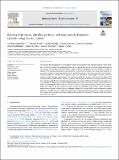Por favor, use este identificador para citar o enlazar a este item:
http://hdl.handle.net/10261/199558COMPARTIR / EXPORTAR:
 SHARE SHARE
 CORE
BASE CORE
BASE
|
|
| Visualizar otros formatos: MARC | Dublin Core | RDF | ORE | MODS | METS | DIDL | DATACITE | |

| Título: | Relating high ozone, ultrafine particles, and new particle formation episodes using cluster analysis |
Autor: | Carnerero, Cristina CSIC ORCID ; Pérez, Noemí CSIC ORCID; Petäjä, Tuukka; Laurila, Tiia; Ahonen, Lauri R.; Kontkanen, Jenni; Ahn, Kang-Ho; Alastuey, Andrés CSIC ORCID; Querol, Xavier CSIC ORCID | Palabras clave: | Rural station Balloon soundings Cluster analysis Photochemical pollutants Urban influence Tropospheric ozone Ultrafine particles Vertical distribution |
Fecha de publicación: | oct-2019 | Editor: | Elsevier | Citación: | Atmospheric Environment: X 4: 100051 (2019) | Resumen: | We studied the simultaneity of tropospheric ozone (O3) episodes, high ultrafine particle (UFP; diameter < 100 nm) concentrations, and the occurrence of new particle formation at a regional background station in the Western Mediterranean (northeast Spain), which is affected considerably by the transport of pollutants emitted in the Barcelona metropolitan area and nearby populated and industrial areas. Using cluster analysis, we categorized summer and spring days between 2014 and 2018 according to their daily cycles of O3 concentrations, and then studied the evolution of the particle number size distribution, meteorological variables, and black carbon and sulfur dioxide concentrations. The analysis revealed that, in spring and summer, the highest UFP concentrations coincided with the highest O3 episodes, but new particle formation was largely inhibited during these episodes, probably due to the high aerosol pollution load transported from the Barcelona metropolitan area to the station. In contrast, new particle formation episodes were concurrent with the lowest concentrations of O3 and UFPs, including the number of particles in the 9–25 nm size range. Measurements carried out in an intensive field study, using an air ion spectrometer and a particle size magnifier, support these results. In addition, measurements obtained onboard tethered balloons revealed that sea and land breezes transported regional pollutants vertically up to about 400 m above ground level. This coincided with episodes of vertical recirculation of air masses that lasted for several days, which resulted in high O3 and high UFP episodes, while new particle formation was inhibited. © 2019 The Authors | Versión del editor: | https://doi.org/10.1016/j.aeaoa.2019.100051 | URI: | http://hdl.handle.net/10261/199558 | DOI: | 10.1016/j.aeaoa.2019.100051 |
| Aparece en las colecciones: | (IDAEA) Artículos |
Ficheros en este ítem:
| Fichero | Descripción | Tamaño | Formato | |
|---|---|---|---|---|
| Relating high ozone, ultrafine particles, and new particle formation episodes using cluster analysis.pdf | Artículo principal | 2,73 MB | Adobe PDF |  Visualizar/Abrir |
| ScienceDirect_files_07-46-09.437.zip | Material suplementario | 7,75 MB | Unknown | Visualizar/Abrir |
CORE Recommender
SCOPUSTM
Citations
14
checked on 13-abr-2024
WEB OF SCIENCETM
Citations
12
checked on 29-feb-2024
Page view(s)
196
checked on 18-abr-2024
Download(s)
135
checked on 18-abr-2024
Google ScholarTM
Check
Altmetric
Altmetric
NOTA: Los ítems de Digital.CSIC están protegidos por copyright, con todos los derechos reservados, a menos que se indique lo contrario.
